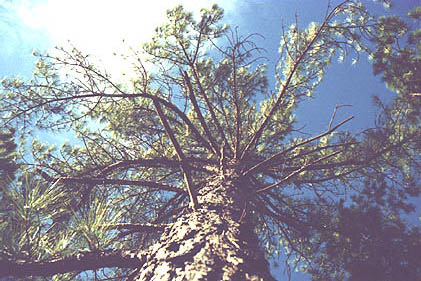
"Barking" up a Loblolly pine -- Pearson Creek
"Diligence is the mother of good luck." -- English proverb
Pine Bark and Wood

"Barking" up a Loblolly pine -- Pearson Creek
"There is no excellent beauty that hath not some strangeness in proportion." -- Francis Bacon, Essays: Of Beauty
Production of wood and bark begins in the cambium, a one cell thick layer beneath the inner bark. This remarkable layer of cells produces both the tissue destined to become the bark and the wood. The layer produced on exterior side of the cambium is called phloem or inner bark that contains sieve tubes that transport sugars and amino acids (synthesized in the leaves) downward to the roots.
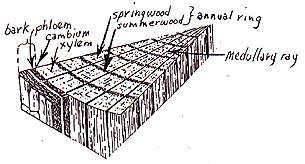
On the inner side, the cambium produces the xylem or sapwood which has three structural components: (a) trachieds which are channels derived from long spindle-shaped cells and which transport water upward from the roots to the leaves. The trachieds are 3 - 11 millimeters long and their side walls have tiny pores called pits which allow communication from one trachied to the next and thus it possible for the water to ascend the entire length of the tree (in the angiosperms there are corresponding larger and continuous and more efficient water-conducting channels called vessels). Also present in the xylem are (b)medullary rays (extending radially from the center of the trunk on cross section), which allow transport between layers of xylem produced in different years. In addition in the xylem, there are (c) resin ducts (mostly parallel with the trachieds, appearing as small dots on cross section) which conduct non-volatile resin (terpentine and hard rosin mixture) produced by specialized cells lining these ducts. In the Strobus (haploxylon) subgenus of pines ("White pines"), the trachieds have smooth inner walls and resin ducts are less numerous whereas the trachieds in Pinus (diploxylon) subgenus pines ("Yellow pines") have dentate (jagged) inner walls and resin ducts are more numerous.
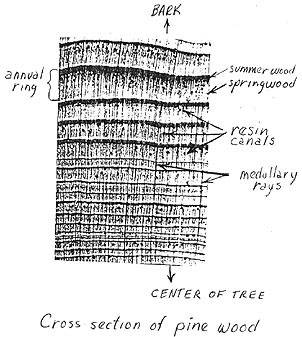
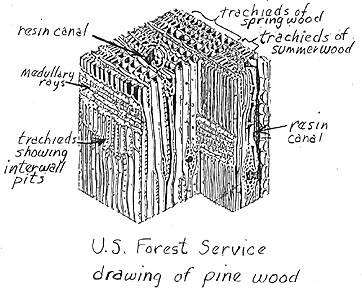
The cells of the phloem are eventually crushed against the inner surface of the bark and they dry out and ultimately become the next inner layer of the bark, contributing to the increasing thickness of the bark as the tree ages... The phloem cells of the "White" (or"Soft") pines remain alive longer than that of the "Yellow" (or "Hard") pines and hence the forming inner layer of bark expands more proportionately with the increasing girth of the growing tree trunk and fewer fissures develop and therefor the Strobus subgenus ("White Pines") of pines generally has smoother bark at any given age.
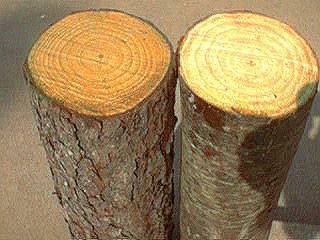
Loblolly pine (a "Yellow Pine") on left,
Eastern White pine (a "White Pine" ) on right.
(Approximately same age)
Note: Smoother bark and lighter wood and less
distinct rings of the"White Pine"
(Strobus subgenus) [right]) compared to the "Yellow
Pine" (Pinus subgenus) [left].
The cells of the xylem or sapwood (so called because its
trachieds carry sap upward) live longer and hence form a thicker
layer than the phloem. But gradually these cells also die and
leave a core of heartwood, the inner wood which is no
longer alive in a physiologic sense, but which provides important
structural support. This wood is impregnated with resins which
resists decay.
This process of new layers of wood formation by the cambium writes a "history" of the tree's growth by leaving a pattern of annual rings (a.k.a. tree rings or growth rings). In the Spring the newly formed wood has larger thin-walled trachieds and is a lighter color. This is followed in the summer by relatively slower growth of smaller thick-walled trachieds which are darker. Hence there is a cross sectional pattern of alternating light ("springwood") and the darker, stronger ("summerwood") annual rings which vary in width according to enviornmental conditions. When water and other conditions are favorable and the pine tree is young and vigorous, growth is rapid and the annual rings are wide. During periods of drought or sunlight deprivation (as, a small tree under a dense forest canopy) the rings are narrow.
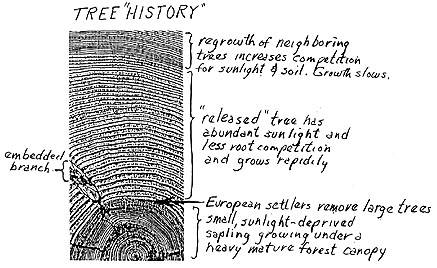
The study of climate-induced tree ring patterns was developed by A. E. Douglass into the discipline of dendrochronology in the early 1900's (now an extensive Laboratory of Tree-Ring Research) at the University of Arizona. Dendrochronology is the most effective method of analysis of past climatic patterns and determining the age of wood, such as that used in the structures of prehistoric peoples.
An interesting pattern of tree rings results in leaning trees because the tree tries to straighten its trunk by producing more wood on side, called reaction wood. Conifer trees tend to straighten their trunks by producing producing wider annual growth rings on the underside of the leaning trunk, gradually pushing it to a more vertical position and hence is called compression wood. In contrast, angiosperm (broadleaf) trees produce the wider annual ring on the upper side of the lean and to straighten the tree it would seem to exert a pull, hence the reaction wood is called tension wood.
The chemical composition of pine wood (other genera are similar) is approximately: 42% cellulose, 25% hemicellulose, 30% lignin, and 3% pectin, starch, ash, other. The principal component cellulose is a polymer of glucose (about 10,000 glucose units per cellulose molecule) which forms tiny microfibrils which aggregate to form larger elementary fibrils, the principal constituent of the tracheid walls. The shorter chain hemicelluloses ( 150 - 200 glucose units) fill spaces between cellulose chains and various size fibrils. The lignin is a phenolic compound (benzene with attached methoxy, propyl and hydroxy groups) which is tightly bound to the cellulose. In the production of paper in pulp mills, chemical removal of the lignin (the waste product and pollutant) leaves a water-cellulose fiber mixture which is dried and rolled in a series of heated cylinders which compresses the fibers together, forming a sheet of paper.